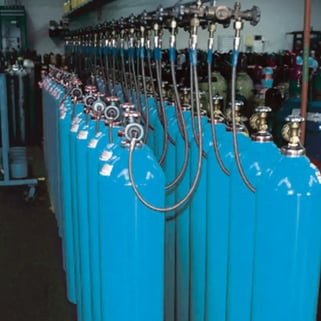By: Craig Pagano on May 18th, 2023
Flexible Hoses Part 1: Understanding the Basics
hose mfg | Medical Gas Supplies | industrial gas supplies | cryogenic equipment | hoses
How well do you know your flexible hoses? Do the terms ‘permeation,’ ‘post-sintered’ or ‘bend radius’ have meaning or do they seem more like unintelligible industry jargon? If it’s the latter, you’re not alone! Bottom line, it’s easy to order the wrong hose.
Ratermann is here to help. Below we’ve got the basics you need to understand hose terminology, and more importantly, choose the correct hose for your application.

Why flexible hoses?
Let’s start with the ‘why’ behind flexible hoses. Flexible hoses are a staple in the cryogenic and compressed gas industry for the transfer of gases and liquids, and they’ve come a long way in terms of safety and durability. Flexible hoses are THE answer to the biggest problems created by rigid hoses: cracking and leaking.
Ratermann has an exhaustive selection of flexible hoses for cryogenic and compressed gas applications from high pressure to CO2 to tube trailers. Whether you’re working with liquified nitrogen, oxygen or argon or compressed gases like oxygen, helium and hydrogen, we have a hose in-stock for your application. And if an off-the-shelf hose doesn't fit the bill, we can create a custom solution.
Most common flexible hose materials:
There are several choices to consider when choosing a hose: stainless steel, PTFE (polytetrafluoroethylene) and composite materials are among the most common. These are chosen for their ability to withstand extreme temperatures, high pressures and corrosive environments. The hose material you choose will depend on your application. (Stay tuned for Flexible Hoses Part 2, where we’ll deep dive into hose materials and applications.)
Important hose terms:
There are a number of terms that pop up when talking about flexible hoses for cryogenic and compressed gases. Here’s a brief glossary of some of the most common terms, phrases and acronyms you’ll see:
Adapters: Refers to accessories to reduce or enlarge the size of a connection or hose line, used to bridge a hose assembly.
Adiabatic Compression: This refers to the heat generated by compressing air that remains in the compressed air.
Armor Casing: Armor casing can easily be installed over a braided hose to prevent kinking and whipping in the event of a hose burst. It also protects the hose exterior from incidental damage.
Bend Radius: The minimum distance a hose can be bent without causing damage.
Braiding: A stainless steel braid that encases the inner core and gives the hose its strength to hold pressure. A high pressure hose can have from one (3,000 PSI) to four braids (5,000 PSI) depending on pressure requirements.
Burst Pressure: Maximum pressure before a hose will rupture. Make sure the average working pressure of the hose is well above the required maximum pressure of your application.
CCB: Clean, Capped & Bagged - meaning that a hose is cleaned and ready for oxygen service.
CGA: The Compressed Gas Association is a trade association for the industrial and medical gas supply industry, and publishes standards and practices to codify industry practices.
Diffusion/Effusion: Diffusion occurs when gas molecules disperse throughout a container. Effusion occurs when a gas passes through a small opening, often described as a pinhole. Hoses that effuse gases can also diffuse gases. Diffusion can introduce contaminants that could affect the high purity gas stream. If this is a concern, consider using an all-metal hose.
FNPT: Female national pipe threads.
MAWP: Maximum Allowable Working Pressure is the maximum pressure for which the hose assembly is designed.
Molecular Size: The size of molecules that a hose can effectively contain or prevent from passing through. For example, hydrogen and helium have the smallest molecular weight, and thus present a higher risk of permeation loss.
Permeation: How gas molecules pass through the pores of a hose. If permeation is a concern, consider using an all-metal hose. Make certain the flow rate is below the suggested threshold level. Alternative options are ETFE or PTFE post sintered hoses, which reduce effusion by around 75 percent.
Post Sintered: A process used to enhance the properties of a material by improving strength, density, etc. Essentially, heating or ‘baking’ a material to a temperature just below its melting point, causing it to fuse into a solid mass.
Swivel Fittings: Fittings that allow the coupling and hose connection to rotate, preventing kinking and excessive bending.
Velocity or SCFH: The amount of flow a hose is rated for, as standard cubic feet per hour (SCFH).
Choosing a hose? Ask these questions.
As we mentioned earlier, it’s all too easy to order the wrong hose – either because of a misunderstanding of hose terminology or of how important it is to match the hose with your application. To prevent wasting time and money, ask these questions when selecting a hose:
- What is the application? Do you need a hose for high pressure gas or cryogenic liquids?
- What is the maximum pressure in your application?
- What is the flow rate (SCFH)?
- What length is needed? Standard lengths are in-stock and ready to ship, custom lengths can be ordered. It’s also a good idea to give yourself extra length, just in case.
- What type of end fittings do you need? The most common are ¼” female NPT.
- Do you need armor to protect the hose from kinking and reducing whip?
- Do you need CCB for oxygen service?
- Do you need swivels, tethers, or other special options?
Ratermann has the hoses you need in-stock and ready to ship!
Shop our extensive hose collection or check out our Hose Builder tool to build the right hose for your application!


